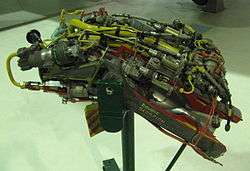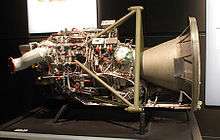Napier Scorpion
| Country of origin | United Kingdom |
|---|---|
| Manufacturer | Napier |
| Application | aircraft booster |
| Liquid-fuel engine | |
| Propellant | hydrogen peroxide / kerosene |
| Performance | |
| Thrust | 4,000 lbf (17.8 kN) |
The Napier Scorpion was a British liquid-fuelled rocket engine developed and manufactured by Napier. It used hydrogen peroxide / kerosene propellant chemistry.[1]
Scorpion
The first Scorpion NSc.1 was successfully flight-tested in a Canberra.[2]
Double Scorpion
 Double Scorpion, RAF Museum London | |
| Manufacturer | Napier |
|---|---|
| Application | aircraft booster |
| Predecessor | Napier Scorpion |
| Liquid-fuel engine | |
| Propellant | hydrogen peroxide / kerosene |
| Configuration | |
| Chamber | two |
| Performance | |
| Thrust | 8,000 lbf (35.6 kN) |
| Dimensions | |
| Length | 856mm (33.7in) |
| Diameter | 584mm (23in) |
| Dry weight | 98kg (216lb) |
| Application | aircraft booster |
|---|---|
| Predecessor | Napier Double Scorpion |
| Liquid-fuel engine | |
| Propellant | hydrogen peroxide / kerosene |
| Configuration | |
| Chamber | three, independently fired |
| Performance | |
| Thrust | 12,000 lbf (53.4 kN) |
From 1956 the Double Scorpion NScD.1 [3] was fitted experimentally to two Canberra light bombers, to improve high altitude performance.[2][4]
A world altitude record of 70,300 feet (21,427 m) was set by Canberra WK163 on 28 August 1957.[5] This was on the eve of cancellation of manned aircraft programmes by the 1957 Defence White Paper.
The Double Scorpion was also considered for use in the English Electric P.1A interceptor (which gave rise to the Lightning).[2] The company Aerojet General was chosen for United States production.[6]
Cancellation
The Scorpion project was cancelled in February 1959, at a reported total cost of £1.25 million.[7]
Notes and references
| Wikimedia Commons has media related to Napier Scorpion. |
- ↑ "United Kingdom Aerospace and Weapons Projects: Rocket Engines". Skomer.
- 1 2 3 "Scorpion" (PDF). Flight. 73 (2579): 900. 27 June 1958.
- ↑ "Napier Double Scorpion" (PDF). Flight: 338. 30 August 1957.
- ↑ Compiled by Alan Vessey (1997). Napier Powered. Tempus. ISBN 0-7524-0766-X.
- ↑ "Napier Rocket Engines" (PDF). The English Electric Journal. June 1957.
- ↑ Popular Science. February 1958. Missing or empty
|title=(help) - ↑ "Cancelled projects: the list up-dated" (PDF). Flight: 262. 17 August 1967.
